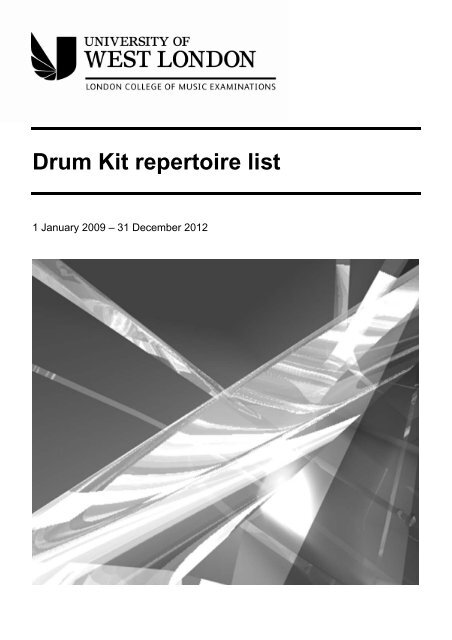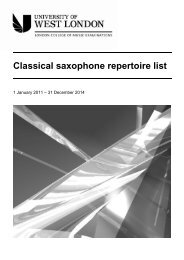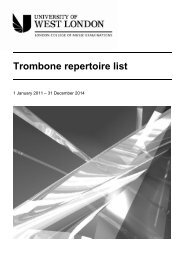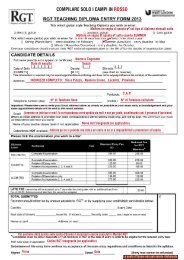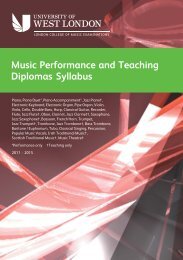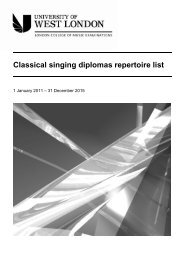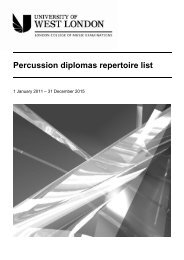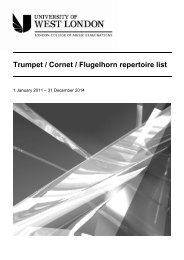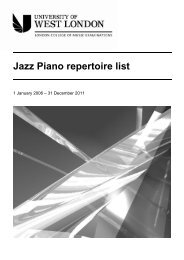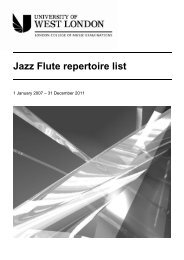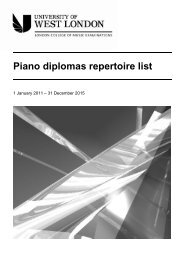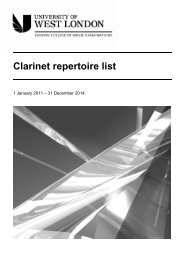LCM Exams - Drum Kit Grades repertoire list - esamilcm.it
LCM Exams - Drum Kit Grades repertoire list - esamilcm.it
LCM Exams - Drum Kit Grades repertoire list - esamilcm.it
Create successful ePaper yourself
Turn your PDF publications into a flip-book with our unique Google optimized e-Paper software.
<strong>Drum</strong> <strong>K<strong>it</strong></strong> <strong>repertoire</strong> <strong>list</strong><br />
1 January 2009 – 31 December 2012
DRUM KIT<br />
2009-2012<br />
Contents<br />
Page<br />
The Philosophy of this Syllabus .......................................... 3<br />
Guidelines ........................................................................... 4<br />
Publications ......................................................................... 5<br />
Related Examinations ......................................................... 5<br />
Grade 1 ............................................................................... 6<br />
Grade 2 ............................................................................... 7<br />
Grade 3 ............................................................................... 8<br />
Grade 4 ............................................................................... 9<br />
Grade 5 ............................................................................... 10<br />
Grade 6 ............................................................................... 11<br />
Grade 7 ............................................................................... 12<br />
Grade 8 ............................................................................... 13<br />
Viva voce ............................................................................ 14<br />
Aural tests ........................................................................... 16<br />
This <strong>repertoire</strong> <strong>list</strong> should be read in conjunction w<strong>it</strong>h the Syllabus for<br />
Graded and Leisure Play Examinations in Music Performance. Copies<br />
are available free of charge from <strong>LCM</strong> Examinations (tel: 020 8231 2364),<br />
from local representatives or on uwl.ac.uk/lcmexams<br />
Leisure Play examinations are also available, for candidates who wish to<br />
play pieces only. Please see Section 5 of the syllabus for details.<br />
This <strong>repertoire</strong> <strong>list</strong> is valid from 1 January 2009 until 31 December 2012.
<strong>LCM</strong> Examinations<br />
Director of Examinations<br />
John Howard BA PhD<br />
Chief Examiner in Music<br />
Philip Aldred BEd F<strong>LCM</strong><br />
Univers<strong>it</strong>y of West London<br />
<strong>LCM</strong> Examinations<br />
St Mary’s Road<br />
Ealing<br />
London<br />
W5 5RF<br />
tel: +44 (0)20 8231 2364<br />
fax: +44 (0)20 8231 2433<br />
email: lcm.exams@uwl.ac.uk<br />
uwl.ac.uk/lcmexams<br />
© Copyright 2011 by the Univers<strong>it</strong>y of West London, <strong>LCM</strong> Examinations<br />
2
The Philosophy of this Syllabus<br />
The core aims are to establish a clear path of progression from one exam to the next, and to ensure that<br />
each section of the exam is relevant to the needs of the candidate.<br />
This approach is based on well-researched teaching of techniques. It is recognised that concepts of<br />
syncopation and different time values are not inherent. Such concepts require development in a logical<br />
method. The exercises and pieces are designed to aid that development. Rudiments are played using<br />
the drum k<strong>it</strong>, which <strong>it</strong> is hoped will help candidates to relate to their use in a wider sense, and avoid the<br />
scenario of such disciplines being learnt ‘just for the sake of an examination’, w<strong>it</strong>hout any notion of their<br />
practical application, and consequently being forgotten almost instantly after the examination.<br />
The progressive integration of the rudiments into the pieces as the examinations progress also aims to<br />
avoid this problem. The important technical and educational benef<strong>it</strong>s of fundamental technique are thus<br />
gained in a pos<strong>it</strong>ive and rewarding way. The pieces reflect a wide range of styles, in order to familiarise<br />
students w<strong>it</strong>h a comprehensive understanding of different rhythmic concepts, as well as the ever-popular<br />
rock drumming patterns.<br />
This syllabus reflects a need for both solo and ensemble performance. There is a dearth of solo music<br />
for drum k<strong>it</strong>, and <strong>it</strong> is hoped that the inclusion of a wide range of pieces as options for each grade may<br />
help to fill that void, and provide other opportun<strong>it</strong>ies in add<strong>it</strong>ion to ensemble playing. At the same time,<br />
we recognise that the abil<strong>it</strong>y to accompany other musicians is one of the principal tasks of the drummer,<br />
and to that end, each grade includes three accompanied pieces, of which one must be chosen for the<br />
exam. At <strong>Grades</strong> 7 and 8, a study played to the accompaniment of a click track must also be included.<br />
The aim has been to choose a range of pieces for each grade that should enable the candidate at that<br />
level, w<strong>it</strong>h sufficient prior study, to achieve a really musical result. Care has been taken to avoid pieces<br />
that, whilst ‘technically’ playable at a certain grade of playing, present a level of difficulty such that the<br />
candidate is unlikely to be able to develop other (non-technical) aspects of the music. This in no sense<br />
implies that the standard of musical performance expected is lower than previous, or other, syllabuses.<br />
Rather <strong>it</strong> stresses that <strong>it</strong> is the overall qual<strong>it</strong>y of musical (rather than just technical) performance and<br />
interpretation that is considered foremost. The syllabus is organised in such a way that technical<br />
demands are developed in a carefully structured, cumulative way.<br />
Principal syllabus compilers: Jack Richards and Aidan Geary<br />
3
Guidelines<br />
EQUIPMENT:<br />
1. Candidates will be expected to provide their own drum k<strong>it</strong>, unless arrangements are made in<br />
advance w<strong>it</strong>h the centre representative to use equipment at the venue. It is the responsibil<strong>it</strong>y of the<br />
candidate to ensure that instruments required for all <strong>it</strong>ems are available.<br />
2. Time will be allowed at the beginning of the examination to adjust the k<strong>it</strong>, but this should not exceed<br />
3 minutes. The k<strong>it</strong> <strong>it</strong>self should be set up well in advance of the examination start time, and<br />
dismantled later.<br />
3. A five-piece drum k<strong>it</strong> is required for all grades. A single crash/ride cymbal (in add<strong>it</strong>ion to hi-hats)<br />
may be used for <strong>Grades</strong> 1 and 2. A separate crash cymbal is required for Grade 3 and above.<br />
Electronic k<strong>it</strong>s are not perm<strong>it</strong>ted. ‘Flats’ may only be used up to and including Grade 4.<br />
4. A candidate using inappropriate or damaged sticks may be prevented from taking the examination.<br />
5. Candidates should bring their own sticks and music to the examination.<br />
6. If, in the opinion of the examiner, a candidate’s choice of sticks or technique demonstrates a<br />
potential to damage instruments, and/or if the dynamic level of the performance combined w<strong>it</strong>h the<br />
acoustics of the examination venue const<strong>it</strong>utes a health and safety hazard, the examinations can be<br />
terminated.<br />
7. Centre representatives should note that a CD player is required for the administration of the aural<br />
tests at <strong>Grades</strong> 6-8. In some circumstances a CD player will also be required for lower grades.<br />
TECHNICAL GUIDELINES:<br />
1. Rudiments may be played using left-hand leads, if appropriate, by left-handed players. If a lefthanded<br />
k<strong>it</strong> arrangement is required then a separate k<strong>it</strong> will be required in the examination room.<br />
2. Suggested tempi for all requirements are <strong>list</strong>ed in the examination books.<br />
3. All Technical Work requirements (Rudiments) must be played as wr<strong>it</strong>ten (including repeats) from<br />
memory.<br />
4. Crushed rolls may be used in all pieces. A high standard of rolling is not expected in <strong>Grades</strong> 1-3.<br />
5. Some lim<strong>it</strong>ed creative embellishment of the printed score is acceptable when performing the<br />
accompanied piece at Grade 6 and above.<br />
6. Candidates should consult and use the examination handbook for the relevant grade which contains<br />
all the required music and also gives fuller details, examples and information on ALL sections of the<br />
examination. Photocopies are not perm<strong>it</strong>ted (see syllabus Regulation 22).<br />
7. At <strong>Grades</strong> 7 & 8, candidates should use their discretion in adapting the tempi of linked rudiments to<br />
enable the links to be fluent and musical.<br />
ACCOMPANIMENT:<br />
1. All candidates at <strong>Grades</strong> 1-6 must select TWO solo pieces and ONE accompanied piece for their<br />
exam (pre-recorded backing track or live piano accompaniment). At <strong>Grades</strong> 7-8 candidates must<br />
choose ONE solo piece, ONE Time Sequence Study to be performed w<strong>it</strong>h a click track, and ONE<br />
accompanied piece.<br />
2. All pieces must be performed as published in the Handbooks, i.e. accompanied pieces may not be<br />
performed solo, and solo pieces may not be performed w<strong>it</strong>h accompaniment.<br />
3. At <strong>Grades</strong> 1-4, piano accompaniments are published for three pieces per grade. At <strong>Grades</strong> 5-8 only<br />
one piano accompaniment is published. If a piano accompaniment is used, this must be performed<br />
live. A pre-recorded piano accompaniment will not be acceptable. (The piece ‘<strong>Drum</strong> and Bass<br />
Groove’ at Grade 8 is published w<strong>it</strong>h bass gu<strong>it</strong>ar accompaniment and the same cond<strong>it</strong>ions apply.)<br />
4
4. CDs containing pre-recorded backing tracks for accompanied pieces are included w<strong>it</strong>h the<br />
handbooks. Candidates using these CDs in the examination are responsible for providing their own<br />
playback equipment (see syllabus Regulation 23). CDs used must be published by <strong>LCM</strong><br />
Examinations – the use of copies is not perm<strong>it</strong>ted.<br />
5. Candidates entering for Leisure Play examinations may present a solo programme.<br />
Publications<br />
The following publications are relevant to this syllabus:<br />
• <strong>Drum</strong> <strong>K<strong>it</strong></strong> Handbook: <strong>Grades</strong> 1 & 2 (LL207)<br />
• <strong>Drum</strong> <strong>K<strong>it</strong></strong> Handbook: <strong>Grades</strong> 3 & 4 (LL208)<br />
• <strong>Drum</strong> <strong>K<strong>it</strong></strong> Handbook: <strong>Grades</strong> 5 & 6 (LL209)<br />
• <strong>Drum</strong> <strong>K<strong>it</strong></strong> Handbook: <strong>Grades</strong> 7 & 8 (LL210)<br />
Each Handbook includes the rudiments and pieces for each grade, sample viva voce questions, sight<br />
reading extracts and aural tests.<br />
Each Handbook comes w<strong>it</strong>h a CD which includes the backing tracks for accompanied pieces in the<br />
following formats: (i) drums + backing track; (ii) backing track only. The CDs also include aural test<br />
specimen tracks at <strong>Grades</strong> 6-8 and click tracks for the Time Sequence Studies at <strong>Grades</strong> 7-8.<br />
<strong>LCM</strong> Publications are distributed by Music Exchange<br />
(tel: 0161 946 9301; email: mail@music-exchange.co.uk).<br />
A complete <strong>list</strong> of t<strong>it</strong>les may be found on their webs<strong>it</strong>e – www.music-exchange.co.uk<br />
Related Examinations<br />
<strong>LCM</strong> Examinations offers examinations in a wide range of subjects, covering classical, jazz, pop/rock<br />
and trad<strong>it</strong>ional music genres. The following syllabuses may also be of interest:<br />
• Graded and leisure play examinations for tuned percussion, snare drum, timpani and combined<br />
percussion<br />
• Performance diplomas (four levels) in percussion<br />
• Teaching diplomas (three levels) in percussion<br />
A flexible Ensemble syllabus is also available, catering for all types of ensemble from duets and trios up<br />
to concert bands and wind bands. Six levels are offered, ranging from <strong>Grades</strong> 1-2 to Dip<strong>LCM</strong> standard.<br />
Syllabuses are available free of charge from the <strong>LCM</strong> <strong>Exams</strong> office or from local representatives, or may<br />
be downloaded from the <strong>LCM</strong> <strong>Exams</strong> webs<strong>it</strong>e.<br />
5
DRUM KIT: GRADE ONE<br />
Component 1 - Technical Work (Rudiments)<br />
15 marks<br />
To be played from memory, as shown in the Handbook:<br />
1. Single Stroke Roll<br />
2. Double Stroke Roll<br />
3. Paradiddles<br />
The examiner will ask for a selection of these to be performed.<br />
Component 2 - Performance<br />
60 marks<br />
Performance of three pieces, one from each <strong>list</strong>: A, B and C. TWO solo pieces and ONE accompanied<br />
piece (*) must be chosen.<br />
A Jack Richards Breaker<br />
Aidan Geary Tiptoe Rock<br />
* Tony Stockley Psychedelic<br />
B Claire Brock Rock Waltz<br />
Aidan Geary The Typewr<strong>it</strong>er<br />
* Tony Stockley Lazy Summer<br />
C Brian Stone The Caterpillar Rhumba<br />
Claire Brock<br />
Two Tribes<br />
* Jack Richards Pipe Dream<br />
Component 3 - Viva Voce<br />
7 marks<br />
See pages 14-15.<br />
Component 4 - Sight Reading<br />
10 marks<br />
Up to one minute’s preparation time will be allowed to study the test before playing, during which the<br />
candidate may try parts of the test if they wish. Tests may include repeat bars.<br />
Component 5 - Aural Tests<br />
8 marks<br />
See pages 16-18.<br />
The <strong>LCM</strong> Grade 1 & 2 <strong>Drum</strong> <strong>K<strong>it</strong></strong> Handbook (LL207) contains all the pieces set for this examination,<br />
and includes a CD containing backing tracks for accompanied pieces (these three pieces are also<br />
published w<strong>it</strong>h piano accompaniment). The book also contains all the required Rudiments, together<br />
w<strong>it</strong>h examples of the Viva Voce, Sight Reading, and Aural Tests sections of the examination. See<br />
page 5 for details.<br />
6
DRUM KIT: GRADE TWO<br />
Component 1 - Technical Work (Rudiments)<br />
15 marks<br />
To be played from memory, as shown in the Handbook:<br />
1. Single Stroke Roll<br />
2. Double Stroke Roll<br />
3. Paradiddles<br />
4. Flams<br />
5. Drags<br />
6. Ruffs<br />
7. Five Stroke Roll<br />
8. Seven Stroke Roll<br />
9. Nine Stroke Roll<br />
The examiner will ask for a selection of these to be performed.<br />
Component 2 - Performance<br />
60 marks<br />
Performance of three pieces, one from each <strong>list</strong>: A, B and C. TWO solo pieces and ONE accompanied<br />
piece (*) must be chosen.<br />
A Aidan Geary Jarg Rock<br />
Aidan Geary Pick up the Beat<br />
* Allan Gubbins Rock Up<br />
B Brian Stone Drill It!<br />
Aidan Geary Trooping the Colour<br />
* Aidan Geary The Temple Skip<br />
C Jack Richards Simple Samba<br />
Brian Stone<br />
Rambo Mambo<br />
* Tony Stockley Rattlesnake<br />
Component 3 - Viva Voce<br />
7 marks<br />
See pages 14-15.<br />
Component 4 - Sight Reading<br />
10 marks<br />
Up to one minute’s preparation time will be allowed to study the test before playing, during which the<br />
candidate may try parts of the test if they wish. Tests may include repeat bars.<br />
Component 5 - Aural Tests<br />
8 marks<br />
See pages 16-18.<br />
The <strong>LCM</strong> Grade 1 & 2 <strong>Drum</strong> <strong>K<strong>it</strong></strong> Handbook (LL207) contains all the pieces set for this examination,<br />
and includes a CD containing backing tracks for accompanied pieces (these three pieces are also<br />
published w<strong>it</strong>h piano accompaniment). The book also contains all the required Rudiments, together<br />
w<strong>it</strong>h examples of the Viva Voce, Sight Reading, and Aural Tests sections of the examination. See<br />
page 5 for details.<br />
7
DRUM KIT: GRADE THREE<br />
Component 1 - Technical Work (Rudiments)<br />
15 marks<br />
To be played from memory, as shown in the Handbook:<br />
1. Single Strokes<br />
2. Double Strokes<br />
3. Paradiddles<br />
4. Flams<br />
5. Drags<br />
6. Ruffs<br />
7. Five Stroke Roll<br />
8. Seven Stroke Roll<br />
9. Nine Stroke Roll<br />
10. Flam Tap<br />
11. Double Paradiddle<br />
12. Paradiddle Diddle<br />
The examiner will ask for a selection of these to be performed.<br />
Component 2 - Performance<br />
60 marks<br />
Performance of three pieces, one from each <strong>list</strong>: A, B and C. TWO solo pieces and ONE accompanied<br />
piece (*) must be chosen.<br />
A Brian Stone Get It<br />
Aidan Geary Ronnie’s Rush<br />
* Tony Stockley Jump Back<br />
B Daniel Earley Even Swirl<br />
Aidan Geary Wiley Jazz Waltz<br />
* Jack Richards Gospel Oak<br />
C John M<strong>it</strong>chell Samba Reggae<br />
Daniel Earley Rhumba-bumba<br />
* Tony Stockley Cool Breeze<br />
Component 3 - Viva Voce<br />
7 marks<br />
See pages 14-15.<br />
Component 4 - Sight Reading<br />
10 marks<br />
The extract may include simple fills, repeat bars and ad lib. sections. Up to one minute’s preparation time<br />
will be allowed to study the test before playing, during which the candidate may try parts of the test if they<br />
wish.<br />
Component 5 - Aural Tests<br />
8 marks<br />
See pages 16-18.<br />
The <strong>LCM</strong> Grade 3 & 4 <strong>Drum</strong> <strong>K<strong>it</strong></strong> Handbook (LL208) contains all the pieces set for this examination,<br />
and includes a CD containing backing tracks for accompanied pieces (these three pieces are also<br />
published w<strong>it</strong>h piano accompaniment). The book also contains all the required Rudiments, together<br />
w<strong>it</strong>h examples of the Viva Voce, Sight Reading, and Aural Tests sections of the examination. See<br />
page 5 for details.<br />
8
DRUM KIT: GRADE FOUR<br />
Component 1 - Technical Work (Rudiments)<br />
15 marks<br />
To be played from memory, as shown in the Handbook:<br />
1. Single Strokes<br />
2. Double Strokes<br />
3. Paradiddles<br />
4. Flams<br />
5. Drags<br />
6. Ruffs<br />
7. Five Stroke Roll<br />
8. Seven Stroke Roll<br />
9. Nine Stroke Roll<br />
10. Flam Accent<br />
11. Flamacue<br />
12. Flam Tap<br />
13. Drag and Stroke<br />
14. Double Drag and Stroke<br />
15. Double Paradiddle<br />
16. Paradiddle Diddle<br />
The examiner will ask for a selection of these to be performed.<br />
Component 2 - Performance<br />
60 marks<br />
Performance of three pieces, one from each <strong>list</strong>: A, B and C. TWO solo pieces and ONE accompanied<br />
piece (*) must be chosen.<br />
A Jimmy Roman Break That Beat<br />
Aidan Geary X-hat Men<br />
* Allan Gubbins Ghost Town<br />
B Daniel Earley Show Off!<br />
Clive Malabar Shuffle Up<br />
* Allan Gubbins Shuffledom<br />
C Phil Bailey Splash Out<br />
Peter Precious Caribbean Carnival<br />
* Claire Brock Country Girl<br />
Component 3 - Viva Voce<br />
7 marks<br />
See pages 14-15.<br />
Component 4 - Sight Reading<br />
10 marks<br />
The extract may include simple fills, repeat bars and ad lib. sections. Up to one minute’s preparation time<br />
will be allowed to study the test before playing, during which the candidate may try parts of the test if they<br />
wish.<br />
Component 5 - Aural Tests<br />
8 marks<br />
See pages 16-18.<br />
The <strong>LCM</strong> Grade 3 & 4 <strong>Drum</strong> <strong>K<strong>it</strong></strong> Handbook (LL208) contains all the pieces set for this examination,<br />
and includes a CD containing backing tracks for accompanied pieces (these three pieces are also<br />
published w<strong>it</strong>h piano accompaniment). The book also contains all the required Rudiments, together<br />
w<strong>it</strong>h examples of the Viva Voce, Sight Reading, and Aural Tests sections of the examination. See<br />
page 5 for details.<br />
9
DRUM KIT: GRADE FIVE<br />
Component 1 - Technical Work (Rudiments)<br />
15 marks<br />
To be played from memory, as shown in the Handbook:<br />
1. Single Strokes<br />
2. Double Strokes<br />
3. Paradiddles<br />
4. Flams<br />
5. Drags<br />
6. Ruffs<br />
7. Five Stroke Roll<br />
8. Seven Stroke Roll<br />
9. Nine Stroke Roll<br />
10. Flam Accent<br />
11. Flamacue<br />
12. Flam Tap<br />
13. Flam Paradiddles<br />
14. Drag Paradiddles<br />
15. Drag and Stroke<br />
16. Double Drag and Stroke<br />
17. Double Paradiddles<br />
18. Paradiddle Diddle<br />
The examiner will ask for a selection of these to be performed.<br />
Component 2 - Performance<br />
60 marks<br />
Performance of three pieces, one from each <strong>list</strong>: A, B and C. TWO solo pieces and ONE accompanied<br />
piece (*) must be chosen.<br />
A Tony Stockley Off the Hat<br />
Daniel Earley Disco Waves<br />
* Jack Richards Hobo’s Groove<br />
B Brian Stone March Around<br />
Matthew Thomas Anyone for Tens<br />
* Allan Gubbins One Man Samba<br />
C Tony Stockley Swing It<br />
Aidan Geary East Side Swing<br />
* Aidan Geary Ice Cream Scooper ♫<br />
Component 3 - Viva Voce<br />
7 marks<br />
See pages 14-15.<br />
Component 4 - Sight Reading<br />
10 marks<br />
The extract may include fills, repeat bars, and lim<strong>it</strong>ed improvisation. Up to one minute’s preparation time will<br />
be allowed to study the test before playing, during which the candidate may try parts of the test if they wish.<br />
Component 5 - Aural Tests<br />
8 marks<br />
See pages 16-18.<br />
The <strong>LCM</strong> Grade 5 & 6 <strong>Drum</strong> <strong>K<strong>it</strong></strong> Handbook (LL209) contains all the pieces set for this examination,<br />
and includes a CD containing backing tracks for accompanied pieces (one piece (♫) is also<br />
published w<strong>it</strong>h piano accompaniment). The book also contains all the required Rudiments, together<br />
w<strong>it</strong>h examples of the Viva Voce, Sight Reading, and Aural Tests sections of the examination. See<br />
page 5 for details.<br />
10
DRUM KIT: GRADE SIX<br />
Component 1 - Technical Work (Rudiments)<br />
15 marks<br />
To be played from memory, as shown in the Handbook:<br />
1. Single Strokes<br />
2. Double Strokes<br />
3. Paradiddles<br />
4. Flams<br />
5. Drags<br />
6. Ruffs<br />
7. Five Stroke Roll<br />
8. Seven Stroke Roll<br />
9. Nine Stroke Roll<br />
10. Eleven Stroke Roll<br />
11. Flam Accent<br />
12. Flamacue<br />
13. Flam Tap<br />
14. Flam Paradiddles<br />
15. Drag Paradiddles<br />
16. Drag and Stroke<br />
17. Double Drag and Stroke<br />
18. Double Paradiddles<br />
19. Paradiddle Diddle<br />
20. Swiss Army Triplets<br />
The examiner will ask for a selection of these to be performed.<br />
Component 2 - Performance<br />
60 marks<br />
Performance of three pieces, one from each <strong>list</strong>: A, B and C. TWO solo pieces and ONE accompanied<br />
piece (*) must be chosen.<br />
A Jack Richards Stand By<br />
Tony Stockley Latrok<br />
* Allan Gubbins Isla Dance<br />
B Brian Stone One and Six<br />
Miles Williams Rollercoaster<br />
* Claire Brock Deuce’s Shuffle ♫<br />
C Tony Stockley Rocking<br />
Brian Stone<br />
Out and Round<br />
* Aidan Geary Cazza’s Improv<br />
Component 3 - Viva Voce<br />
7 marks<br />
See pages 14-15.<br />
Component 4 - Sight Reading<br />
10 marks<br />
The extract may include fills, repeat bars, and lim<strong>it</strong>ed improvisation. Up to one minute’s preparation time will be allowed<br />
to study the test before playing, during which the candidate may try parts of the test if they wish.<br />
Component 5 - Aural Tests<br />
8 marks<br />
See pages 16-18.<br />
The <strong>LCM</strong> Grade 5 & 6 <strong>Drum</strong> <strong>K<strong>it</strong></strong> Handbook (LL209) contains all the pieces set for this examination,<br />
and includes a CD containing backing tracks for accompanied pieces, and aural test specimen<br />
extracts. One piece (♫) is published w<strong>it</strong>h piano accompaniment. The book also contains all the<br />
required Rudiments, together w<strong>it</strong>h examples of the Viva Voce, Sight Reading, and Aural Tests<br />
sections of the examination. See page 5 for details.<br />
11
DRUM KIT: GRADE SEVEN<br />
Component 1 - Technical Work (Rudiments)<br />
15 marks<br />
To be played from memory, as shown in the Handbook.<br />
1. Single Strokes<br />
2. Double Strokes<br />
3. Paradiddles<br />
4. Flams<br />
5. Drags<br />
6. Ruffs<br />
7. Five Stroke Roll<br />
8. Seven Stroke Roll<br />
9. Nine Stroke Roll<br />
10. Eleven Stroke Roll<br />
11. Flam Accent<br />
12. Flamacue<br />
13. Flam Tap<br />
14. Flam Paradiddles<br />
15. Drag Paradiddles<br />
16. Drag and Stroke<br />
17. Double Drag and Stroke<br />
18. Double Paradiddles<br />
19. Paradiddle Diddle<br />
20. Swiss Army Triplets<br />
The examiner will ask for a selection of these to be performed. In add<strong>it</strong>ion, the examiner may request any<br />
TWO of the above rudiments to be combined into a single pattern, in the order: ABAB-fill. Candidates<br />
should use their discretion in adapting the tempi of linked rudiments to enable the links to be fluent and<br />
musical.<br />
Component 2 - Performance<br />
60 marks<br />
Performance of three pieces. ONE solo piece, ONE piece performed w<strong>it</strong>h a click track ( † ) and ONE<br />
accompanied piece (*) must be chosen.<br />
Aidan Geary Funk the Stuff<br />
†<br />
Brian Stone Time Sequence Study 1<br />
* Aidan Geary Power Tower<br />
Brian Stone<br />
The Style Machine<br />
†<br />
Jack Richards Time Sequence Study 2<br />
* Miles Williams Latin for my Valentine ♫<br />
Brian Stone<br />
Urban Mix<br />
†<br />
Jack Richards Time Sequence Study 3<br />
* Allan Gubbins Hippedy Hop<br />
NB: references to Lists A, B and C in the Grade 7&8 handbook should be disregarded.<br />
Component 3 - Viva Voce<br />
7 marks<br />
See pages 14-15.<br />
Component 4 - Sight Reading<br />
10 marks<br />
The extract may include fills, repeat bars and improvisation. Up to one minute’s preparation time will be<br />
allowed to study the test before playing, during which the candidate may try parts of the test if they wish.<br />
Component 5 - Aural Tests<br />
8 marks<br />
See pages 16-18.<br />
The <strong>LCM</strong> Grade 7 & 8 <strong>Drum</strong> <strong>K<strong>it</strong></strong> Handbook (LL210) contains all the pieces set for this examination,<br />
and includes a CD containing backing tracks for accompanied pieces and aural test specimen<br />
extracts. One piece (♫) is published w<strong>it</strong>h piano accompaniment. The book also contains all the<br />
required Rudiments, together w<strong>it</strong>h examples of the Viva Voce, Sight Reading, and Aural Tests<br />
sections of the examination. See page 5 for details.<br />
12
DRUM KIT: GRADE EIGHT<br />
Theory of Music Grade Five must have been passed (see Regulations).<br />
Component 1 - Technical Work (Rudiments)<br />
15 marks<br />
To be played from memory, as shown in the Handbook:<br />
1. Single Strokes<br />
2. Double Strokes<br />
3. Paradiddles<br />
4. Flams<br />
5. Drags<br />
6. Ruffs<br />
7. Five Stroke Roll<br />
8. Seven Stroke Roll<br />
9. Nine Stroke Roll<br />
10. Eleven Stroke Roll<br />
11. Flam Accent<br />
12. Flamacue<br />
13. Flam Tap<br />
14. Flam Paradiddles<br />
15. Drag Paradiddles<br />
16. Drag and Stroke<br />
17. Double Drag and Stroke<br />
18. Double Paradiddles<br />
19. Paradiddle Diddle<br />
20. Swiss Army Triplets<br />
The examiner will ask for a selection of these to be performed. In add<strong>it</strong>ion, the examiner may request any<br />
THREE of the above rudiments to be combined into a single pattern, in the order: ABC-ABC-fill. Candidates<br />
should use their discretion in adapting the tempi of linked rudiments to enable the links to be fluent and<br />
musical.<br />
Component 2 - Performance<br />
60 marks<br />
Performance of three pieces. ONE solo piece, ONE piece performed w<strong>it</strong>h a click track ( † ) and ONE<br />
accompanied piece (*) must be chosen.<br />
Tony Stockley Jack’s X/Hat Groove<br />
†<br />
Aidan Geary Time Sequence Study 1<br />
* Claire Brock Five Days [NB: to be performed w<strong>it</strong>h CD]<br />
Claire Brock<br />
Tumbao<br />
†<br />
Aidan Geary Time Sequence Study 2<br />
* Tony Stockley <strong>Drum</strong> and Bass Groove [NB. to be performed w<strong>it</strong>h live bass gu<strong>it</strong>ar accompaniment]<br />
Peter Precious Show of Hands<br />
†<br />
Aidan Geary Time Sequence Study 3<br />
* John M<strong>it</strong>chell Curtain Up [NB. to be performed w<strong>it</strong>h live piano accompaniment]<br />
NB: references to Lists A, B and C in the Grade 7&8 handbook should be disregarded.<br />
Component 3 - Viva Voce<br />
7 marks<br />
See pages 14-15.<br />
Component 4 - Sight Reading<br />
10 marks<br />
The extract may include fills, repeat bars and improvisation. Up to one minute’s preparation time will be<br />
allowed to study the test before playing, during which the candidate may try parts of the test if they wish.<br />
Component 5 - Aural Tests<br />
8 marks<br />
See pages 16-18.<br />
The <strong>LCM</strong> Grade 7 & 8 <strong>Drum</strong> <strong>K<strong>it</strong></strong> Handbook (LL210) contains all the pieces set for this examination,<br />
and includes a CD containing backing tracks for accompanied pieces and aural test specimen<br />
extracts. Accompaniment parts for Bass gu<strong>it</strong>ar / Piano are provided for starred pieces. The book<br />
also contains all the required Rudiments, together w<strong>it</strong>h examples of the Viva Voce, Sight Reading,<br />
and Aural Tests sections of the examination. See page 5 for details.<br />
13
Viva Voce<br />
Notes:<br />
1. Most questions and answers are verbal; however, some responses may require candidates to<br />
indicate certain parts of the drum k<strong>it</strong>, and from Grade 4 onwards there is a requirement to<br />
demonstrate certain rhythmic styles by playing them on the k<strong>it</strong>. Otherwise, candidates are not<br />
expected to demonstrate on the drum k<strong>it</strong>; but they may choose to do so if they feel that this would<br />
clarify their answer.<br />
2. There is no set form of words, or number of questions. Examiners are encouraged to conduct the<br />
tests in a flexible and conversational manner. The number of questions asked, and the content of<br />
the questions, may differ from candidate to candidate. However, the prime focus for the Viva Voce<br />
will always be the music performed in the Performance section of the exam, together w<strong>it</strong>h technical<br />
knowledge of the drum k<strong>it</strong>.<br />
3. The knowledge required for the Viva Voce is cumulative for <strong>Grades</strong> 1-8; i.e. any knowledge required<br />
in earlier grades is required for later grades.<br />
4. Although accuracy and appropriateness of response are the principal cr<strong>it</strong>eria of assessment,<br />
examiners will also look for articulacy, use of correct terminology, and a sense of engagement w<strong>it</strong>h,<br />
and understanding of, the music performed.<br />
5. Sample questions are given in the Handbooks.<br />
Requirements:<br />
GRADE 1<br />
Candidates should be able to:<br />
• name, and explain the meaning of, all basic notational elements in the music performed in the Performance<br />
component of the exam (drum k<strong>it</strong> parts only), including: staff, bars and bar-lines, stave pos<strong>it</strong>ion of different k<strong>it</strong><br />
components, rhythmic values of notes and rests (including dotted notes), time signatures, dynamics,<br />
articulation markings, ornaments, rolls, and any add<strong>it</strong>ional markings;<br />
• explain which is their favour<strong>it</strong>e piece and why;<br />
• assign simple descriptive words to pieces to describe their mood ('happy', 'sad', 'bouncy', 'jazzy', 'gentle',<br />
etc.)<br />
• identify all the names of the drums in the k<strong>it</strong> (illustrated in the examination handbook);<br />
• explain the origin of the name of the snare drum and the name of <strong>it</strong>s components (illustrated in the<br />
examination handbook).<br />
GRADE 2<br />
In add<strong>it</strong>ion to the requirements for Grade 1, candidates may be asked to:<br />
• explain the function and use of the various components of the drum k<strong>it</strong>.<br />
GRADE 3<br />
In add<strong>it</strong>ion to the requirements for <strong>Grades</strong> 1 and 2, candidates may be asked to:<br />
• describe the mood or character of pieces using appropriate descriptive terminology ('fast and lively', 'gentle<br />
and flowing', 'like a dance', etc.);<br />
• identify contrasts of mood w<strong>it</strong>hin pieces;<br />
• discuss any pictorial or descriptive element of the music.<br />
14
GRADE 4<br />
In add<strong>it</strong>ion to the requirements for <strong>Grades</strong> 1-3, candidates may be asked to:<br />
• discuss their approaches to learning the pieces, and to identify any particular difficulties (musical or<br />
technical) which were encountered;<br />
• answer questions on tuning techniques and durabil<strong>it</strong>y of heads of the drum k<strong>it</strong>;<br />
• demonstrate some knowledge of the following rhythmic styles: March, Latin, Shuffle, Rock and Swing.<br />
GRADE 5<br />
In add<strong>it</strong>ion to the requirements for <strong>Grades</strong> 1-4, candidates may be asked to:<br />
• demonstrate knowledge of basic formal structures (e.g. contrasting or repeated sections);<br />
• describe the style of the music performed, and show a developing understanding of rhythmic styles,<br />
including disco.<br />
GRADE 6<br />
In add<strong>it</strong>ion to the requirements for <strong>Grades</strong> 1-5, candidates may be asked to:<br />
• discuss their personal responses to the music performed: the extent to which they like or dislike <strong>it</strong>, or find <strong>it</strong><br />
challenging or rewarding, and why;<br />
• approaches to learning the music, including the use of certain techniques, and aspects of interpretation;<br />
• demonstrate knowledge of formal structures (e.g. ternary, binary, rondo etc.), and of formal patterning w<strong>it</strong>hin<br />
the music (e.g. repet<strong>it</strong>ion or variation of certain rhythmic figures);<br />
• demonstrate a self-cr<strong>it</strong>ical awareness of their own performance, indicating to the examiner which aspects of<br />
their performance they were happy or unhappy w<strong>it</strong>h, and why;<br />
• show a competent awareness of the rhythmic style and use of the drum k<strong>it</strong> such as may be found in show<br />
music and concert bands;<br />
• demonstrate knowledge and understanding of the construction and use of various specia<strong>list</strong> drum k<strong>it</strong>s.<br />
GRADE 7<br />
In add<strong>it</strong>ion to the requirements for <strong>Grades</strong> 1-6, candidates may be asked to:<br />
• demonstrate a widening musical awareness a l<strong>it</strong>tle beyond the music performed;<br />
• identify the style of a fundamental rhythm pointed out in the book by the examiner;<br />
• demonstrate a thorough knowledge of the workings and maintenance of the drum k<strong>it</strong> and the effect of<br />
different pieces of equipment available, e.g. fusion k<strong>it</strong>, effects cymbals, etc.<br />
GRADE 8<br />
In add<strong>it</strong>ion to the requirements for <strong>Grades</strong> 1-7, candidates may be asked to:<br />
• discuss w<strong>it</strong>h the examiner a range of issues arising from the music performed, demonstrating evidence of a<br />
rounded musical awareness, in terms both of the <strong>repertoire</strong> <strong>it</strong>self, and the candidate's response to <strong>it</strong> as a<br />
performer;<br />
• discuss w<strong>it</strong>h the examiner those styles and performers which have been influential in the development of<br />
their own playing;<br />
• demonstrate a comprehensive knowledge of recognised musical styles and some of the history and<br />
development of the drum k<strong>it</strong>.<br />
15
Aural Tests<br />
Notes:<br />
1. These tests are normally administered by the examiner using the drum k<strong>it</strong>. Where this is the case,<br />
the candidate is perm<strong>it</strong>ted to watch while the examiner plays the extracts. However, in certain<br />
circumstances, tests using drum k<strong>it</strong> extracts may be administered using a CD. For further<br />
information, please contact <strong>LCM</strong> Examinations.<br />
2. Specimen test examples are given in the Handbooks. Candidates and teachers should note that,<br />
even though the format of some tests stays the same from grade to grade, the complex<strong>it</strong>y of the<br />
examples used increases.<br />
3. Candidates may request any test to be given one repeat playing w<strong>it</strong>hout loss of marks.<br />
4. Please note that the printed wording is a guide only. Examiners are encouraged to conduct the tests<br />
in a conversational manner.<br />
Requirements:<br />
GRADE 1<br />
A click-pulse will be given, followed by a rhythmic phrase played twice on the snare drum, in one of the<br />
following time signatures: 2/4, 3/4, 4/4. Candidates will be asked to:<br />
1. state the time signature [2 marks].<br />
The candidate will be given a copy of three notated extracts. One of these extracts will be played, twice, on<br />
the drum k<strong>it</strong>. Candidates will be asked to:<br />
2. state which extract was played [2 marks].<br />
A short rhythmic phrase will be played, twice, on the drum k<strong>it</strong>. Candidates will be asked to:<br />
3. play the phrase back [2 marks].<br />
A short phrase will be played, twice, on the drum k<strong>it</strong>. Candidates will be asked to:<br />
4. state the style of the extract played. The extract will be in one of the following styles: 4/4 Rock, 3/4 Rock,<br />
Simple Latin (Examples are given in the Handbook) [2 marks].<br />
GRADE 2<br />
A click-pulse will be given, followed by a rhythmic phrase played twice on the snare drum, in one of the<br />
following time signatures: 2/4, 3/4, 4/4, 6/8. Candidates will be asked to:<br />
1. state the time signature [2 marks].<br />
The candidate will be given a copy of three notated extracts. One of these extracts will be played, twice, on<br />
the drum k<strong>it</strong>. Candidates will be asked to:<br />
2. state which extract was played [2 marks].<br />
A short rhythmic phrase will be played, twice, on the drum k<strong>it</strong>. Candidates will be asked to:<br />
3. play the phrase back [2 marks].<br />
A short phrase will be played, twice, on the drum k<strong>it</strong>. Candidates will be asked to:<br />
4. state the style of the extract played. The extract will be in one of the following styles: 4/4 Rock, 3/4 Rock,<br />
Simple Latin, 6/8 March, 2/4 March (Examples are given in the Handbook) [2 marks].<br />
16
GRADE 3<br />
A click-pulse will be given, followed by a rhythmic phrase played twice on the snare drum, in one of the<br />
following time signatures: All those set for previous grades, plus 12/8. Candidates will be asked to:<br />
1. state the time signature [2 marks].<br />
The candidate will be given a copy of three notated extracts. One of these extracts will be played, twice, on<br />
the drum k<strong>it</strong>. Candidates will be asked to:<br />
2. state which extract was played [2 marks].<br />
A short rhythmic phrase will be played, twice, on the drum k<strong>it</strong>. Candidates will be asked to:<br />
3. play the phrase back [2 marks].<br />
A short phrase will be played, twice, on the drum k<strong>it</strong>. Candidates will be asked to:<br />
4. state the style of the extract played. The extract will be in one of the following styles: All those set for previous<br />
grades, plus Slow Blues, Bossa Nova (Examples are given in the Handbook) [2 marks].<br />
GRADE 4<br />
A click-pulse will be given, followed by a rhythmic phrase played twice on the drum k<strong>it</strong>, in one of the following<br />
time signatures: All those set for previous grades, plus 9/8. Candidates will be asked to:<br />
1. state the time signature [2 marks].<br />
The candidate will be given a copy of three notated extracts. One of these extracts will be played, twice, on<br />
the drum k<strong>it</strong>. Candidates will be asked to:<br />
2. state which extract was played [2 marks].<br />
A short rhythmic phrase will be played, twice, on the drum k<strong>it</strong>. Immediately after the second playing,<br />
candidates will be asked to:<br />
3. play a su<strong>it</strong>able answering phrase [2 marks].<br />
A short phrase will be played, twice, on the drum k<strong>it</strong>. Candidates will be asked to:<br />
4. state the style of the extract played. The extract will be in one of the following styles: All those set for previous<br />
grades, plus Shuffle, Swing (Examples are given in the Handbook) [2 marks].<br />
GRADE 5<br />
A click-pulse will be given, followed by a rhythmic phrase played twice on the drum k<strong>it</strong>, in one of the following<br />
time signatures: All those set for previous grades, plus 5/4. Candidates will be asked to:<br />
1. state the time signature [2 marks].<br />
The candidate will be given a copy of three notated extracts. One of these extracts will be played, twice, on<br />
the drum k<strong>it</strong>. Candidates will be asked to:<br />
2. state which extract was played [2 marks].<br />
A short rhythmic phrase will be played, twice, on the drum k<strong>it</strong>. Immediately after the second playing,<br />
candidates will be asked to:<br />
3. play a su<strong>it</strong>able answering phrase [2 marks].<br />
A short phrase will be played, twice, on the drum k<strong>it</strong>. Candidates will be asked to:<br />
4. state the style of the extract played. The extract will be in one of the following styles: All those set for previous<br />
grades, plus Disco 16, Reggae (Examples are given in the Handbook) [2 marks].<br />
17
GRADE 6<br />
An extract of music will be played, twice, via CD. This extract will take the form of a short instrumental ‘track’<br />
featuring a number of parts, but w<strong>it</strong>hout drums. A chord chart will be given to the candidate; this will take the<br />
form of chord symbols and bars only and will not include any other information about the music heard.<br />
1. Candidates will be asked a selection of the following:<br />
• to state the time signature [from any set for previous grades, plus 2/2, 3/2, 4/2, 6/4, 9/4, 12/4];<br />
• to suggest an appropriate tempo marking;<br />
• to identify the style;<br />
• to state whether the music is in a major or minor key;<br />
• to describe and identify any particularly noticeable aspects of the instrumentation, dynamics, texture,<br />
tempo, melody, rhythmic figures, etc. [3 marks]<br />
A few bars, taken from the track, will be played in isolation, followed by another version of the same few bars,<br />
but this time incorporating some changes in aspects such as the tempo, dynamics, instrumentation, style, etc.<br />
Candidates will be asked to:<br />
2. identify the changes [2 marks].<br />
The full extract will be played again, twice. On the second playing, the candidate will be asked to:<br />
3. play along to the extract in a su<strong>it</strong>able style, taking account of any fluctuations of tempo, dynamics, texture,<br />
etc., and adding fills, etc. where appropriate. [3 marks]<br />
GRADE 7<br />
An extract of music will be played, twice, via CD. This extract will take the form of a short instrumental ‘track’<br />
featuring a number of parts, but w<strong>it</strong>hout drums. A chord chart will be given to the candidate; this will take the<br />
form of chord symbols and bars only and will not include any other information about the music heard.<br />
1. Candidates will be asked a selection of the following:<br />
• to state the time signature [from any set for previous grades, plus 5/8, 7/8, 7/4];<br />
• to suggest an appropriate tempo marking;<br />
• to identify the style;<br />
• to state whether the music is in a major or minor key;<br />
• to describe and identify any particularly noticeable aspects of the instrumentation, dynamics, texture,<br />
tempo, melody, rhythmic figures, etc. [3 marks]<br />
A few bars, taken from the track, will be played in isolation, followed by another version of the same few bars,<br />
but this time incorporating some changes in aspects such as the tempo, dynamics, instrumentation, style, etc.<br />
Candidates will be asked to:<br />
2. identify the changes [2 marks].<br />
The full extract will be played again, twice. On the second playing, the candidate will be asked to:<br />
3. play along to the extract in a su<strong>it</strong>able style, taking account of any fluctuations of tempo, dynamics, texture,<br />
etc., and adding fills, etc. where appropriate. [3 marks]<br />
GRADE 8<br />
An extract of music will be played, twice, via CD. This extract will take the form of a short instrumental ‘track’<br />
featuring a number of parts, but w<strong>it</strong>hout drums. A chord chart will be given to the candidate; this will take the<br />
form of chord symbols and bars only and will not include any other information about the music heard.<br />
1. Candidates will be asked a selection of the following:<br />
• to state the time signature;<br />
• to suggest an appropriate tempo marking;<br />
• to identify the style;<br />
• to state whether the music is in a major or minor key;<br />
• to describe and identify any particularly noticeable aspects of the instrumentation, dynamics, texture,<br />
tempo, melody, rhythmic figures, etc. [3 marks]<br />
A few bars, taken from the track, will be played in isolation, followed by another version of the same few bars,<br />
but this time incorporating some changes in aspects such as the tempo, dynamics, instrumentation, style, etc.<br />
Candidates will be asked to:<br />
2. identify the changes [2 marks].<br />
The full extract will be played again, twice. On the second playing, the candidate will be asked to:<br />
3. play along to the extract in a su<strong>it</strong>able style, taking account of any fluctuations of tempo, dynamics, texture,<br />
etc., and adding fills, etc. where appropriate. [3 marks]<br />
18<br />
June 2011


